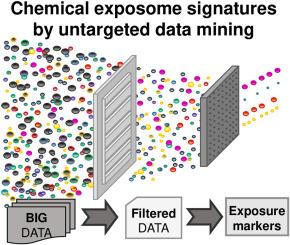从LC-HRMS数据中提取化学暴露特征的非目标数据挖掘策略:应用于早期生命暴露评估的胎粪
IF 6
2区 化学
Q1 CHEMISTRY, ANALYTICAL
引用次数: 0
摘要
近年来,在液相色谱-高分辨率质谱(LC-HRMS)等分析技术进步的推动下,dexposome研究迅速发展,这些技术实现了广泛而敏感的化学覆盖。靶向方法侧重于已知化合物,而非靶向代谢组学方法提供了更全面的观点,并可能揭示暴露生物标志物,但它们不是专门设计用于检测外源性化学物质的。在非目标LC-HRMS数据生成的庞大而复杂的数据集中识别相关的暴露标记仍然是一个重大的分析和计算挑战,需要创新的数据挖掘策略。我们开发了一种新的非靶向数据挖掘策略,从复杂的LC-HRMS数据集中提取外源化学特征。该方法集成了同位素特征富集(ISE)、生物转化信息特征选择和“暴露率”度量。当应用于EDEN队列的胎粪数据时,该策略通过只保留那些显示有效碳同位素模式的特征,导致特征数量减少了六倍。质量缺陷图显示了特定区域单卤化物种和推测的偶联和非偶联代谢物的特征。将ISE结果整合到化学式预测中,显著减少了候选元素的数量,提高了标注效率。通过检测已知的暴露标记,如对乙酰氨基酚、咖啡因和尼古丁,支持子宫内暴露于异种抗生素。这些结果证明了该方法在复杂生物基质中揭示暴露体信号的潜力。本研究提出了一种新的数据挖掘策略,通过保留基于同位素特征的化学可靠特征来降低非靶向LC-HRMS数据的复杂性。作为概念的证明,这种策略可以在没有先验知识的情况下检测特定的化学特征和外源化合物。它对各种生物基质的适应性以及与不同高分辨率质谱平台的兼容性使该策略成为暴露研究和早期生命暴露评估的宝贵工具。本文章由计算机程序翻译,如有差异,请以英文原文为准。


An untargeted data mining strategy for extracting chemical exposome signatures from LC-HRMS data: Application to meconium for early-life exposure assessment
Background
Exposome research has expanded rapidly in recent years, driven by advances in analytical techniques such as liquid chromatography-high-resolution mass spectrometry (LC-HRMS), which enable broad and sensitive chemical coverage. Targeted methods focus on known compounds, while untargeted metabolomic approaches provide a more holistic view and may reveal exposure biomarkers, but they are not specifically designed to detect exogenous chemicals. Identifying relevant exposure markers within the vast and complex datasets generated by untargeted LC-HRMS data remains a significant analytical and computational challenge, requiring innovative data mining strategies.
Results
We developed a novel untargeted data mining strategy to extract exogenous chemical signatures from complex LC-HRMS datasets. The approach integrates isotopic signature enrichment (ISE), biotransformation-informed feature selection and an “exposure rate” metric. When applied to meconium data from the EDEN cohort, the strategy led to a six-fold reduction in the number of features by retaining only those exhibiting valid carbon isotope patterns. Mass defect plots revealed signatures of suspect monohalogenated species and putative conjugated and non-conjugated metabolites in a specific region. Incorporating ISE results into the chemical formula prediction significantly reduced the number of candidates, improving annotation efficiency. In utero exposure to xenobiotics was supported by the detection of known exposure markers such as acetaminophen, caffeine and nicotine. These results demonstrate the method's potential to uncover exposomic signals in complex biological matrices.
Significance
This study presents a novel data mining strategy that reduces the complexity of untargeted LC-HRMS data by retaining chemically reliable features based on isotopic signatures. As a proof of concept, this strategy enables the detection of specific chemical signatures and exogenous compounds without prior knowledge. Its adaptability to various biological matrices and its compatibility with different high-resolution mass spectrometry platforms make this strategy a valuable tool for exposome research and early-life exposure assessment.
求助全文
通过发布文献求助,成功后即可免费获取论文全文。
去求助
来源期刊

Analytica Chimica Acta
化学-分析化学
CiteScore
10.40
自引率
6.50%
发文量
1081
审稿时长
38 days
期刊介绍:
Analytica Chimica Acta has an open access mirror journal Analytica Chimica Acta: X, sharing the same aims and scope, editorial team, submission system and rigorous peer review.
Analytica Chimica Acta provides a forum for the rapid publication of original research, and critical, comprehensive reviews dealing with all aspects of fundamental and applied modern analytical chemistry. The journal welcomes the submission of research papers which report studies concerning the development of new and significant analytical methodologies. In determining the suitability of submitted articles for publication, particular scrutiny will be placed on the degree of novelty and impact of the research and the extent to which it adds to the existing body of knowledge in analytical chemistry.
 求助内容:
求助内容: 应助结果提醒方式:
应助结果提醒方式:


